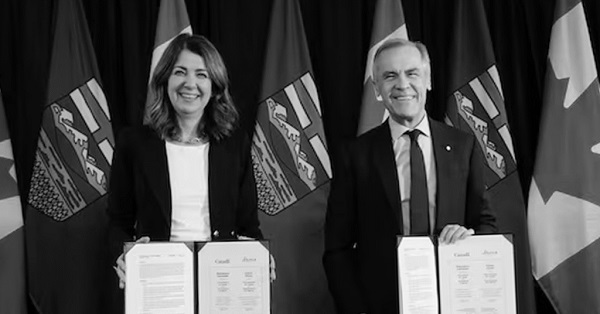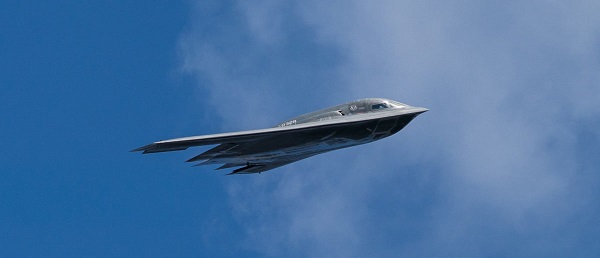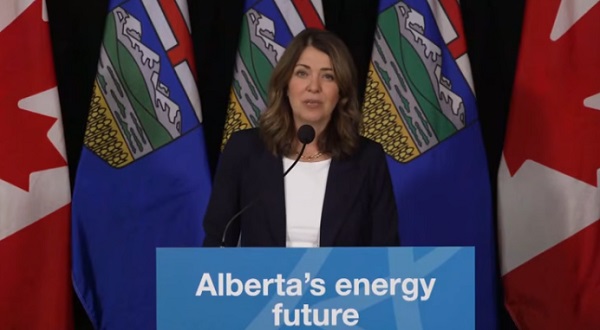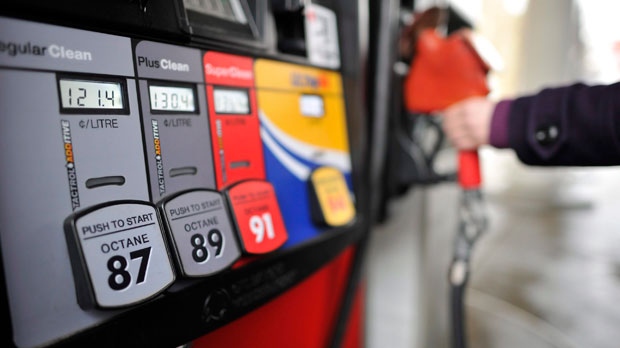Energy
Canada’s Most Impactful Energy Issues in 2024

From EnergyNow.ca
By Deidra Garyk
It feels like we are in the beginning of a cultural, social, and political disruption. The fear of saying the wrong thing and being cancelled is subsiding, resulting in robust debate about important topics. Public pushback against climate alarmism and energy misinformation is getting louder as more and more people join in the discussion.
I have enjoyed watching the increased skepticism and distrust towards “the settled Science” and the agreed upon narratives in favour of open, genuine, inquisitive conversations with a focus on practicable solutions. People are fed up with niche topics taking up a disproportionate amount of airtime in place of issues that are relevant to the majority of the country.
These are a few of the energy topics that I feel were most impactful for the year, with many having a lasting impact into 2025 and beyond.
SHIFTING POLITICAL WINDS
As Canada implements more and more regulatory hurdles for the oil and gas industry, the US re-elected pro-business, pro-oil, political outsider Donald Trump in a ‘uge win, with the majority of counties shifting from blue (Democrat) to red (Republican).

He isn’t even sworn in, and Trump is lighting things up via social media decrees. Using Truth Social, he announced that a 25 percent tariff will be placed on all goods coming from Canada and Mexico unless their respective borders are addressed to his satisfaction.
This will affect all Canadian businesses, not the least being those in the oil patch since 4 million barrels of oil per day go to the US, along with 7.9 billion cubic feet per day of natural gas. 77 percent of Canadian exports enter the US market; therefore, a 25 percent tariff is another obstacle affecting Canadian businesses’ competitiveness, which are already faced with various regulatory and taxation hurdles from Canadian governments, such as the carbon tax that increases each year.
Expect to see a shake-up in the Department of Energy and the narrative around climate and energy with the nomination of Chris Wright, CEO of Liberty Energy, for US Secretary of Energy. Chris has been a bold, unapologetic, pragmatic energy realist who cares about balancing environmental responsibility with resource development to help supply the world with reliable, affordable energy. His principled leadership has elevated him to one of the highest offices in the US.
Chris Wright is not afraid to go against the crowd. Liberty successfully challenged the SEC’s climate reporting rules and were instrumental in getting them halted. You can listen to his clarity of thought as he testifies on the rules before the U.S. House of Representatives’ Financial Services Committee (Chris’ testimony starts at 53:58).
As the first energy secretary to come from the energy sector, I anticipate that the government’s energy messaging and policy is going to shift away from climate alarmism to one of balance and open-mindedness. I hope he staffs the Department with people who understand energy and are not focused on misguided ideology. The ripple effects will be felt around the globe, and now is the time to embrace people’s scepticism and exhaustion with the constant drumbeat of fear about the use of hydrocarbons.
Much like the massive political shift voted in by the Americans, Canadians are also ready for a change. Prime Minister Trudeau and his Liberal party continue to lag in the polls, indicating voters’ displeasure with their policies. Poll aggregator 338Canada predicts a resounding majority for the federal Conservatives. Will we begin to see better energy policy after the next election?

RENEWABLES’ REALITY AND COOLING CLIMATE CLUBS
As a further demonstration of the shifting social and political winds, the net zero climate movement has seen major companies quell their public support for associated initiatives. The appetite for costly net zero commitments from voters who are struggling to pay their bills is waning, and politicians are hearing about it.
Many Republican-led states have pushed back on anti-hydrocarbon, net zero financing, and that has influenced how companies behave, starting with an exodus from Mark Carney’s net zero alliance, GFANZ (Glasgow Financial Alliance for Net Zero). The Net-Zero Insurance Alliance (NZIA), a subset of GFANZ, has lost about half of its members since March 2023. Climate initiatives, like Climate Action 100+ and the Net Zero Banking Alliance (NZBA) are also losing members who are concerned about the consequences of their affiliation with anti-hydrocarbon groups who attempt to influence how businesses conduct their operations, sometimes through coercive involuntary membership and social shaming.
The energy transition continues to face opposition. In summer 2023, the Alberta government placed a temporary, six-month moratorium on renewable energy – wind and solar – projects in an attempt to balance development with agricultural and social concerns. The condemnation from environmental groups and the Alberta NDP was swift and loud, but not always truthful. On the other side were landowners who were concerned about the consequences of the projects on their communities. A documentary, Generation Green, by filmmaker Heidi McKillop, documents the push-pull of renewable project development in Alberta.
The new rules include development limits on certain agricultural lands, protection of viewscapes using buffer zones, and a requirement for an upfront bond to pay for future reclamation costs. Landowners and associations have praised the changes for addressing concerns and being balanced.
January’s polar vortex reconfirmed people’s willingness to rethink some large-scale industrial wind and solar installations. The extreme cold resulted in alerts warning of potential rotating blackouts, reminding Albertans about the need for reliable, affordable, on-demand energy.
At the same time that Canadians are questioning the reliability of our grids, the government went all in on their bet on the adoption of electric vehicles, generously giving EV battery makers billions of taxpayer-funded subsidies to set up shop in Canada. However, plans have hit speed bumps (pun intended).
Sweden’s Northvolt, the recipient of $7.3 billion in loans, equity stakes, and subsidies from Canada, recently filed for bankruptcy protection in the US. The company says this will not affect its Canadian plant, which is being used as collateral to secure bailout financing in the US. Meanwhile, other plants have been delayed. It seems like this may not have been a good “investment” for taxpayers.
Not that the Liberal government has been cautious with our money. Sustainable Development Technology Canada, colloquially referred to as the green slush fund, violated government funding rules and breached conflict-of-interest and ethics laws by improperly giving away millions of dollars. The scandal is so bad that the RCMP are investigating whether or not there was criminal wrongdoing; however, the government has been at a standstill for weeks because the Liberals refuse to hand over documents to help with the investigation.
COP29, THE FINANCE COP(S)
The COP conflab in Baku, Azerbaijan, in November didn’t skip a beat, seemingly ignorant of the shifting support for costly environmental action predicated on alarmism. Its 65,000 delegates waxed lyrical about the need to transfer funds from developed nations who are allegedly responsible for climate change to developing nations who are disproportionately victimized by changing weather conditions. What was dubbed “the New Collective Quantified Goal” (NCQG) on climate finance, governments tripled their handouts to US$300 billion annually by 2035, and got commits from public and private entities to increase that funding to US$1.3 trillion per year by 2035.
No one likes spending other people’s money quite like Minister Steven Guilbeault. You can find a daily outline of Canada’s COP commitments here.
We should have a new environment minister in time for COP30 in Brazil. And thankfully so, my wallet can’t take much more!
REGULATORY RAT’S NEST
In June, with the passage of Bill C-59, the Canadian Competition Act was amended with expanded provisions to address greenwashing complaints, including excessively punitive charges for breaking the new rules. The gag order has silenced oil and gas companies. Many, such as the Pathways Alliance of the six biggest oilsands producers, took down their websites immediately after the changes were announced. Others took down their ESG reports and environmental statements.
Even though oil and gas is likely to be disproportionately targeted and penalized, this Bill is agnostic; complaints can be made against all industries, and the unelected, unaccountable bureaucracy will decide who will and will not be investigated.
The fines are material. $750,000 for an individual’s first offence and $10 million per misrepresentation for a company’s first offense, up to 3% of annual worldwide gross revenues. Analysis from one of the Big Four consulting firms uncovered approximately one potential misrepresentation per page of an ESG report; some reports run close to 100 pages, so the consequences of a fine are impactful, hence the swift reaction from companies.
While business leaders navigate the landmines created by C-59, mandatory sustainability (i.e. ESG) reporting standards are expected to be rolled out next year, with the latest draft issued in the next week or two. The Canadian securities regulator has said they are focused on climate as the first reporting topic. Nevertheless, it is reasonable to expect the Canadian standards will be expanded as the international standards broaden to include biodiversity and human capital, and possibly “just transition”.
In addition to the requirements for publicly traded companies, the feds’ announced mandatory climate reporting for all large, Canadian incorporated companies, including private. Corporations will be forced to publicly disclose their environmental performance while also being hamstrung by the greenwashing changes.
If you feel like an Olympian high jumper, it may be because companies have to be to meet ever higher regulatory requirements set by our federal government. Just when companies think they’ve cleared the bar by voluntarily cutting emissions from production, the feds raise it one foot higher.
November 4 brought the long-awaited draft emissions cap for the oil and gas industry, targeting a 35 percent emissions reduction below 2019 levels by 2030. To say the industry is annoyed is an understatement, and rightfully so.
You can’t keep a good industry down, though! The Canadian Association of Energy Contractors (CAOEC) is forecasting drilling growth in 2025, meaning the industry and its jobs are maintaining a positive trajectory. There’s continued optimism in the patch thanks to increased egress capacity following the start-up of TMX and the near completion of LNG Canada. The CAOEC 2025 forecast anticipates a total of 6,604 wells drilled, a 5.2% increase in rig operating hours, and total jobs (direct and indirect) of 41,800 – all up from 2024. This is good for workers, families, communities, and the economy.
PIPELINE EGRESS PROGRESS
The long-delayed, over-cost Trans Mountain Expansion Project (TMX) became operational on May 1, 2024, proving that we can still build things in Canada. The pipeline allows for the transportation of up to 890,000 barrels per day of oil to the west coast, which has helped narrow the differential of Western Canada Select crude. Congrats to everyone who worked on the project!
Another project of significant national importance is the 670 kilometre Coastal GasLink (CGL), the first pipeline built to the west coast in 70 years. Although the historical pipeline was completed ahead of schedule in late 2023, its completion affected the drilling and development plans of companies this year as we wait for the start up of the LNG Canada facility in 2025. CGL is another reason for optimism.
PERSONAL HIGHLIGHTS AND MILESTONES
2024 marks 20 years in the patch for me. I’ve had the opportunity to work alongside many astute, industrious, innovative folks who have integrity and heart for their work and co-workers. I thank each of you for shaping my career.
In February, I moderated EnergyNow’s event The Road Ahead: Alberta Energy 2024 with Minister of Energy and Minerals Brian Jean and distinguished energy analyst Dave Yager. We sold out the Petroleum Club ballroom and filled the room with lively discussion and camaraderie.
I then had the honour of moderating the sold-out luncheon panel at the 2024 Lloydminster Heavy Oil Show in September, featuring Alberta Premier Danielle Smith and Saskatchewan Premier Scott Moe. They graciously answered my questions, including one on the Keystone Pipeline – the new “hot topic”.
Premier Smith predicted that a change in US government could see the project resurrected. The Republicans took control of the White House, the Senate, and the House, so we will see if the Premier gets her wish. You can listen to her full answer here and a shorter clip here.
As we close off another fortunate year, I wish all the best for 2025.
Deidra Garyk is the Founder and President of Equipois:ability Advisory, a consulting firm specializing in sustainability solutions. Over 20 years in the Canadian energy sector, Deidra held key roles, where she focused on a broad range of initiatives, from sustainability reporting to fostering collaboration among industry stakeholders through her work in joint venture contracts.
Outside of her professional commitments, Deidra is an energy advocate and a recognized thought leader. She is passionate about promoting balanced, fact-based discussions on energy policy, and sustainability. Through her research, writing, and public speaking, Deidra seeks to advance a more informed and pragmatic dialogue on the future of energy.
Energy
Unceded is uncertain

Tsawwassen Speaker Squiqel Tony Jacobs arrives for a legislative sitting. THE CANADIAN PRESS/Darryl Dyck
From Resource Works
Cowichan case underscores case for fast-tracking treaties
If there are any doubts over the question of which route is best for settling aboriginal title and reconciliation – the courts or treaty negotiations – a new economic snapshot on the Tsawwassen First Nation should put the question to rest.
Thanks to a modern day treaty, implemented in 2009, the Tsawwassen have leveraged land, cash and self-governance to parlay millions into hundreds of millions a year, according to a new report by Deloitte on behalf of the BC Treaty Commission.
With just 532 citizens, the Tsawwassen First Nation now provides $485 million in annual employment and 11,000 permanent retail and warehouse jobs, the report states.
Deloitte estimates modern treaties will provide $1 billion to $2 billion in economic benefits over the next decade.
“What happens, when you transfer millions to First Nations, it turns into billions, and it turns into billions for everyone,” Sashia Leung, director of international relations and communication for the BC Treaty Commission, said at the Indigenous Partnership Success Showcase on November 13.
“Tsawwassen alone, after 16 years of implementing their modern treaty, are one of the biggest employers in the region.”

BC Treaty Commission’s Sashia Leung speaks at the Indigenous Partnerships Success Showcase 2025.
Nisga’a success highlights economic potential
The Nisga’a is another good case study. The Nisga’a were the first indigenous group in B.C. to sign a modern treaty.
Having land and self-governance powers gave the Nisga’a the base for economic development, which now includes a $22 billion LNG and natural gas pipeline project – Ksi Lisims LNG and the Prince Rupert Gas Transmission line.
“This is what reconciliation looks like: a modern Treaty Nation once on the sidelines of our economy, now leading a project that will help write the next chapter of a stronger, more resilient Canada,” Nisga’a Nation president Eva Clayton noted last year, when the project received regulatory approval.
While the modern treaty making process has moved at what seems a glacial pace since it was established in the mid-1990s, there are some signs of gathering momentum.
This year alone, three First Nations signed final treaty settlement agreements: Kitselas, Kitsumkalum and K’omoks.
“That’s the first time that we’ve ever seen, in the treaty negotiation process, that three treaties have been initialed in one year and then ratified by their communities,” Treaty Commissioner Celeste Haldane told me.
Courts versus negotiation
When it comes to settling the question of who owns the land in B.C. — the Crown or First Nations — there is no one-size-fits-all pathway.
Some First Nations have chosen the courts. To date, only one has succeeded in gaining legal recognition of aboriginal title through the courts — the Tsilhqot’in.
The recent Cowichan decision, in which a lower court recognized aboriginal title to a parcel of land in Richmond, is by no means a final one.
That decision opened a can of worms that now has private land owners worried that their properties could fall under aboriginal title. The court ruling is being appealed and will almost certainly end up having to go to the Supreme Court.
This issue could, and should, be resolved through treaty negotiations, not the courts.
The Cowichan, after all, are in the Hul’qumi’num treaty group, which is at stage 5 of a six-stage process in the BC Treaty process. So why are they still resorting to the courts to settle title issues?
The Cowichan title case is the very sort of legal dispute that the B.C. and federal governments were trying to avoid when it set up the BC Treaty process in the mid-1990s.
Accelerating the process
Unfortunately, modern treaty making has been agonizingly slow.
To date, there are only seven modern implemented treaties to show for three decades of works — eight if you count the Nisga’a treaty, which predated the BC Treaty process.
Modern treaty nations include the Nisga’a, Tsawwassen, Tla’amin and five tribal groups in the Maa-nulth confederation on Vancouver Island.
It takes an average of 10 years to negotiate a final treaty settlement. Getting a court ruling on aboriginal title can take just as long and really only settles one question: Who owns the land?
The B.C. government has been trying to address rights and title through other avenues, including incremental agreements and a tripartite reconciliation process within the BC Treaty process.
It was this latter tripartite process that led to the Haida agreement, which recognized Haida title over Haida Gwaii earlier this year.
These shortcuts chip away at issues of aboriginal rights and title, self-governance, resource ownership and taxation and revenue generation.
Modern treaties are more comprehensive, settling everything from who owns the land and who gets the tax revenue from it, to how much salmon a nation is entitled to annually.
Once modern treaties are in place, it gives First Nations a base from which to build their own economies.
The Tsawwassen First Nation is one of the more notable case studies for the economic and social benefits that accrue, not just to the nation, but to the local economy in general.
The Tsawwassen have used the cash, land and taxation powers granted to them under treaty to create thousands of new jobs. This has been done through the development of industrial, commercial and residential lands.
This includes the development of Tsawwassen Mills and Tsawwassen Commons, an Amazon warehouse, a container inspection centre, and a new sewer treatment plant in support of a major residential development.
“They have provided over 5,000 lease homes for Delta, for Vancouver,” Leung noted. “They have a vision to continue to build that out to 10,000 to 12,000.”
Removing barriers to agreement
For First Nations, some of the reticence in negotiating a treaty in the past was the cost and the loss of tax exemptions. But those sticking points have been removed in recent years.
First Nations in treaty negotiations were originally required to borrow money from the federal government to participate, and then that loan amount was deducted from whatever final cash settlement was agreed to.
That requirement was eliminated in 2019, and there has been loan forgiveness to those nations that concluded treaties.
Another sticking point was the loss of tax exemptions. Under Section 87 of Indian Act, sales and property taxes do not apply on reserve lands.
But under modern treaties, the Indian Act ceases to apply, and reserve lands are transferred to title lands. This meant giving up tax exemptions to get treaty settlements.
That too has been amended, and carve-outs are now allowed in which the tax exemptions can continue on those reserve lands that get transferred to title lands.
“Now, it’s up to the First Nation to determine when and if they want to phase out Section 87 protections,” Haldane said.
Haldane said she believes these recent changes may account for the recent progress it has seen at the negotiation table.
“That’s why you’re seeing K’omoks, Kitselas, Kitsumkalum – three treaties being ratified in one year,” she said. “It’s unprecedented.”
The Mark Carney government has been on a fast-tracking kick lately. But we want to avoid the kind of uncertainty that the Cowichan case raises, and if the Carney government is looking for more things to fast-track that would benefit First Nations and the Canadian economy, perhaps treaty making should be one of them.
Resource Works News
Alberta
This new Canada–Alberta pipeline agreement will cost you more than you think


Canada and Alberta’s new net-zero energy deal is being promoted as progress, but it also brings rising costs. In this video, I break down the increase to Alberta’s industrial carbon price, how those costs can raise fuel, heating, and grocery prices, and why taxpayer-funded carbon-capture projects and potential pipeline delays could add even more. Here’s what this agreement could mean for Canadians.
Watch Nataliya Bankert’s latest video.
-

 Business1 day ago
Business1 day agoRecent price declines don’t solve Toronto’s housing affordability crisis
-

 National2 days ago
National2 days agoMedia bound to pay the price for selling their freedom to (selectively) offend
-

 Bruce Dowbiggin2 days ago
Bruce Dowbiggin2 days agoSometimes An Ingrate Nation Pt. 2: The Great One Makes His Choice
-

 Brownstone Institute2 days ago
Brownstone Institute2 days agoThe Unmasking of Vaccine Science
-

 Censorship Industrial Complex18 hours ago
Censorship Industrial Complex18 hours agoA Democracy That Can’t Take A Joke Won’t Tolerate Dissent
-

 armed forces2 days ago
armed forces2 days agoGlobal Military Industrial Complex Has Never Had It So Good, New Report Finds
-

 Artificial Intelligence1 day ago
Artificial Intelligence1 day agoThe Emptiness Inside: Why Large Language Models Can’t Think – and Never Will
-

 Daily Caller1 day ago
Daily Caller1 day agoTech Mogul Gives $6 Billion To 25 Million Kids To Boost Trump Investment Accounts









